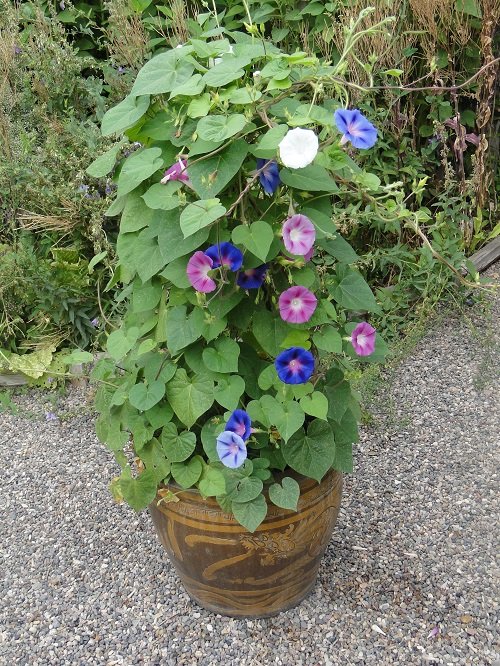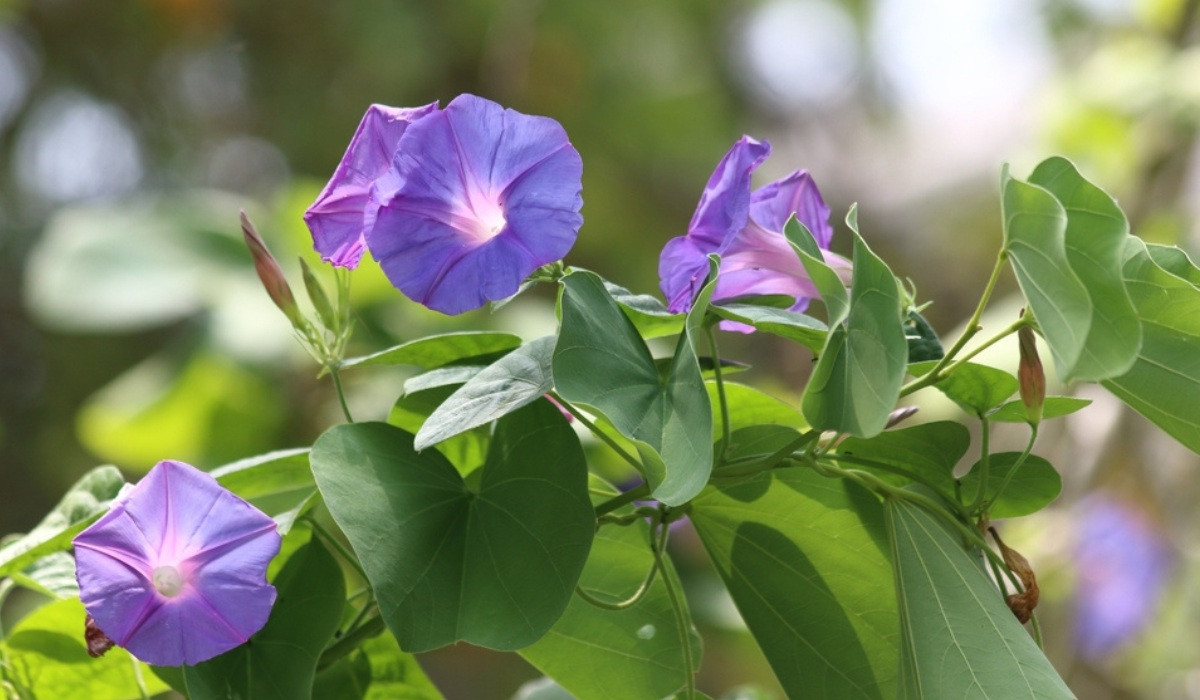Choosing the Perfect Variety for Your Garden
Morning glory flowers come in a stunning array of colors, shapes, and sizes, with over 1,000 species to choose from. From the vibrant blue blooms of the ‘Heavenly Blue’ variety to the delicate, heart-shaped leaves of the ‘Grandpa Ott’ variety, each type of morning glory has its unique characteristics and growth habits. When learning how to plant morning glory, selecting the right variety for your garden is crucial.
Before making a selection, consider the specific growing conditions in your garden. If you live in a region with hot summers, look for varieties that are heat-tolerant, such as the ‘Moonflower’ variety. If you have poor soil, choose a variety that is more forgiving, such as the ‘Cupido’ variety. Some popular varieties of morning glory include ‘Scarlet O’Hara’, ‘Blue Star’, and ‘Pearly Gates’, each with its own unique features and growing requirements.
When selecting a variety, also consider the level of maintenance you’re willing to provide. Some morning glory varieties require regular pruning and training, while others are more low-maintenance. By choosing a variety that fits your climate, soil type, and desired level of maintenance, you’ll be well on your way to successfully growing morning glory and enjoying its beautiful blooms all season long.
Preparing the Soil for Optimal Growth
Before learning how to plant morning glory, it’s essential to prepare the soil for optimal growth. Morning glory plants thrive in well-draining, fertile soil with a pH between 6.0 and 7.0. If your soil is heavy clay, sandy, or lacking in nutrients, take steps to amend it with organic matter.
Start by testing your soil to determine its pH level and nutrient content. Based on the results, add organic matter such as compost, well-rotted manure, or peat moss to improve soil structure and fertility. Mix in a 2-inch layer of organic matter into the top 6-8 inches of soil to create a nutrient-rich growing medium.
For optimal growth, morning glory plants require adequate nutrients, particularly nitrogen, phosphorus, and potassium. Consider adding a balanced fertilizer to the soil before planting, following the manufacturer’s instructions for application rates.
By preparing the soil properly, you’ll provide your morning glory plants with a strong foundation for growth and development. This will help them thrive and produce an abundance of beautiful blooms throughout the growing season.
How to Sow Morning Glory Seeds for Success
When learning how to plant morning glory, sowing seeds at the right time and in the right conditions is crucial for success. In most regions, the ideal time to plant morning glory seeds is in late spring to early summer, when the soil has warmed up to at least 60°F (15°C).
Before sowing, prepare the soil by loosening it to a depth of 12-18 inches. Sow the seeds 1/4 inch deep and 6-8 inches apart, in rows that are 3 feet apart. Cover the seeds with a thin layer of soil and water gently. Keep the soil consistently moist during the first few weeks after planting.
To improve germination rates, make sure the soil is warm and moist. You can also soak the seeds in water for 24 hours before planting to encourage germination. Additionally, consider sowing multiple seeds and thinning them out to 12-18 inches apart once they have 2-3 sets of leaves.
To reduce the risk of seedling disease, avoid overwatering and ensure good air circulation around the plants. You can also use a fungicide specifically designed for seedlings to prevent disease.
By following these steps and tips, you’ll be well on your way to successfully growing morning glory from seed. With proper care and attention, your plants will thrive and produce an abundance of beautiful blooms throughout the growing season.
Providing the Right Conditions for Morning Glory Growth
Morning glory plants require specific growing conditions to thrive. By providing the right amount of sunlight, water, and fertilizer, you can encourage healthy growth and an abundance of blooms.
In terms of sunlight, morning glory plants prefer full sun to partial shade. They require at least 6 hours of direct sunlight per day to produce plenty of flowers. If you’re growing morning glories in a container, make sure to place it in a spot that receives plenty of sunlight.
When it comes to watering, morning glory plants prefer well-draining soil and consistent moisture. Water them deeply once or twice a week, depending on weather conditions. Avoid overwatering, which can lead to root rot and other problems.
Fertilizing morning glory plants is also crucial for optimal growth. Use a balanced fertilizer that’s high in phosphorus to promote blooming. Apply the fertilizer according to the manufacturer’s instructions, usually once a month during the growing season.
For climbing varieties of morning glory, provide support using trellises, arbors, or other structures. This will help the vines grow upwards and produce more blooms. You can also use twine or string to tie the stems to the support, making sure not to constrict the plant.
Regular pruning is also essential for morning glory plants. Prune the vines regularly to promote healthy growth, increase flower production, and maintain plant shape. Remove any dead or damaged leaves or stems, and cut back the vines to encourage new growth.
By providing the right growing conditions, you’ll be able to enjoy a bountiful display of morning glory blooms throughout the growing season. Remember to monitor your plants regularly and adjust their care accordingly to ensure optimal growth and flowering.
Common Pests and Diseases to Watch Out For
When growing morning glory, it’s essential to be aware of common pests and diseases that can affect the plants. By identifying these issues early, you can take steps to prevent infestations and infections, ensuring healthy growth and blooming.
Aphids are one of the most common pests that can affect morning glory plants. These small, soft-bodied insects can cause curled or distorted leaves and stems. To control aphids, use neem oil or insecticidal soap, and introduce natural predators like ladybugs or lacewings.
Whiteflies are another pest that can infest morning glory plants. These tiny, winged insects can transmit diseases and cause yellowing or stunted growth. To control whiteflies, use sticky traps or insecticidal soap, and maintain good air circulation around the plants.
Powdery mildew is a common disease that can affect morning glory plants, especially in humid or wet conditions. This fungal disease causes a white, powdery coating on the leaves and stems, leading to yellowing and defoliation. To prevent powdery mildew, ensure good air circulation, water plants at the base rather than overhead, and apply fungicides as needed.
To prevent pests and diseases, maintain good garden hygiene, remove weeds and debris, and dispose of infected plants. Use organic and integrated pest management solutions whenever possible, and consider introducing beneficial insects like bees and butterflies to promote a balanced ecosystem.
By being aware of these common pests and diseases, you can take proactive steps to prevent infestations and infections, ensuring healthy growth and blooming of your morning glory plants. Remember to monitor your plants regularly and adjust your care accordingly to maintain optimal health.
Tips for Training and Pruning Morning Glory Vines
Training and pruning morning glory vines are essential steps in promoting healthy growth, increasing flower production, and maintaining plant shape. By providing the right support and pruning techniques, you can encourage your morning glory plants to thrive and produce an abundance of blooms.
For climbing varieties of morning glory, provide support using trellises, arbors, or other structures. This will help the vines grow upwards and produce more blooms. You can also use twine or string to tie the stems to the support, making sure not to constrict the plant.
Regular pruning is also crucial for morning glory plants. Prune the vines regularly to promote healthy growth, increase flower production, and maintain plant shape. Remove any dead or damaged leaves or stems, and cut back the vines to encourage new growth.
When pruning, make clean cuts just above a leaf node, using sharp and sterile pruning tools. This will help prevent the spread of disease and encourage new growth. You can also prune morning glory vines to maintain a desired shape or size, or to encourage bushy growth.
In addition to pruning, provide morning glory plants with regular fertilization and watering to promote healthy growth and blooming. By combining these techniques, you can create a stunning display of morning glory blooms in your garden.
Remember to monitor your morning glory plants regularly and adjust your pruning and training techniques accordingly. By providing the right support and care, you can enjoy a bountiful display of blooms throughout the growing season.
Encouraging Blooms and Extending the Flowering Season
Morning glory plants are known for their vibrant, trumpet-shaped blooms, but they can be finicky when it comes to producing flowers. To encourage your morning glory plants to produce more blooms, it’s essential to provide them with the right conditions and care.
Fertilization plays a crucial role in promoting blooming in morning glory plants. Use a balanced fertilizer that is high in phosphorus to promote flower production. Apply the fertilizer according to the manufacturer’s instructions, and avoid over-fertilizing, which can damage the plant.
Deadheading is another technique to encourage blooming in morning glory plants. Remove spent blooms regularly to encourage the plant to produce more flowers. This will also help to maintain the plant’s appearance and promote healthy growth.
Adequate moisture is also essential for promoting blooming in morning glory plants. Water the plants regularly, but avoid overwatering, which can lead to root rot and other problems. Mulch around the base of the plants to retain moisture and suppress weeds.
To extend the flowering season, consider using row covers or cold frames to protect the plants from frost and other weather extremes. This will allow the plants to continue blooming well into the fall and early winter.
Another technique to extend the flowering season is to plant morning glory seeds in succession. Sow new seeds every 2-3 weeks to ensure a continuous supply of blooms throughout the growing season.
By following these tips, you can encourage your morning glory plants to produce more blooms and extend the flowering season. With proper care and attention, you can enjoy a stunning display of morning glory blooms in your garden all season long.
Morning Glory Care and Maintenance: A Seasonal Guide
Morning glory plants require regular care and maintenance to thrive throughout the growing season. By following a seasonal guide, you can ensure your plants receive the right attention at the right time.
Spring: In the spring, morning glory plants begin to emerge from winter dormancy. Remove any dead or damaged foliage, and prune the vines to encourage new growth. Apply a balanced fertilizer to promote healthy growth, and mulch around the base of the plants to retain moisture.
Summer: During the summer months, morning glory plants require regular watering and fertilization. Water the plants deeply once or twice a week, depending on weather conditions. Apply a high-phosphorus fertilizer to promote blooming, and deadhead spent blooms regularly to encourage more flower production.
Fall: In the fall, morning glory plants begin to prepare for winter dormancy. Reduce watering and fertilization, and prune the vines to encourage new growth. Apply a layer of mulch around the base of the plants to protect the roots from frost.
Winter: During the winter months, morning glory plants are dormant. Protect the roots from frost by applying a layer of mulch, and avoid watering or fertilizing the plants. In regions with mild winters, you can propagate new plants from cuttings or seed during this time.
In addition to seasonal care, morning glory plants require regular pruning and training to maintain their shape and promote healthy growth. Prune the vines regularly to encourage new growth, and train the vines to climb up trellises or other supports.
By following this seasonal guide, you can ensure your morning glory plants receive the right care and attention throughout the growing season. With proper care and maintenance, you can enjoy a stunning display of morning glory blooms in your garden all season long.








